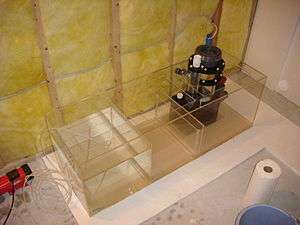Sump (aquarium)


In fishkeeping, a sump is an accessory tank in which mechanical equipment is kept.[1][2] A remote sump allows for a clutter-free display tank.
It is found in mainly in a reef system. The sump sits below the main tank and is used as a filter, as well as a holding place of unsightly, miscellaneous equipment such as protein skimmers, calcium reactors, heaters and the like. The main advantage of having a sump plumbed into an aquarium is the increase of water in the system, making it more stable and less prone to fluctuations of pH and salinity, and also mitigating the effects of nutrient buildup or the unintentional introduction of foreign substances. In addition, some sumps have a compartment that can be converted into a refugium, helping to filter out excess nutrients such as nitrates.
A sump can also improve aeration of the water in the aquarium. As the water moves over the overflow, down the drain and splashing into the sump. This will help with gas exchange between the water and air. Increased dissolved oxygen is beneficial to fish and can also aid in avoiding Cyanobacteria outbreaks [3]
See also
References
- ↑ What is a Sump and Do You Need One for a Saltwater Aquarium?, by Stan & Debbie Hauter, in About.com
- ↑ Everything You Always Wanted to Know About Sumps by Gregory S. Taylor, a complete three-part article in Reefkeeping Magazine
- ↑ The Benefits of an Aquarium Sump by Jeff Hesketh